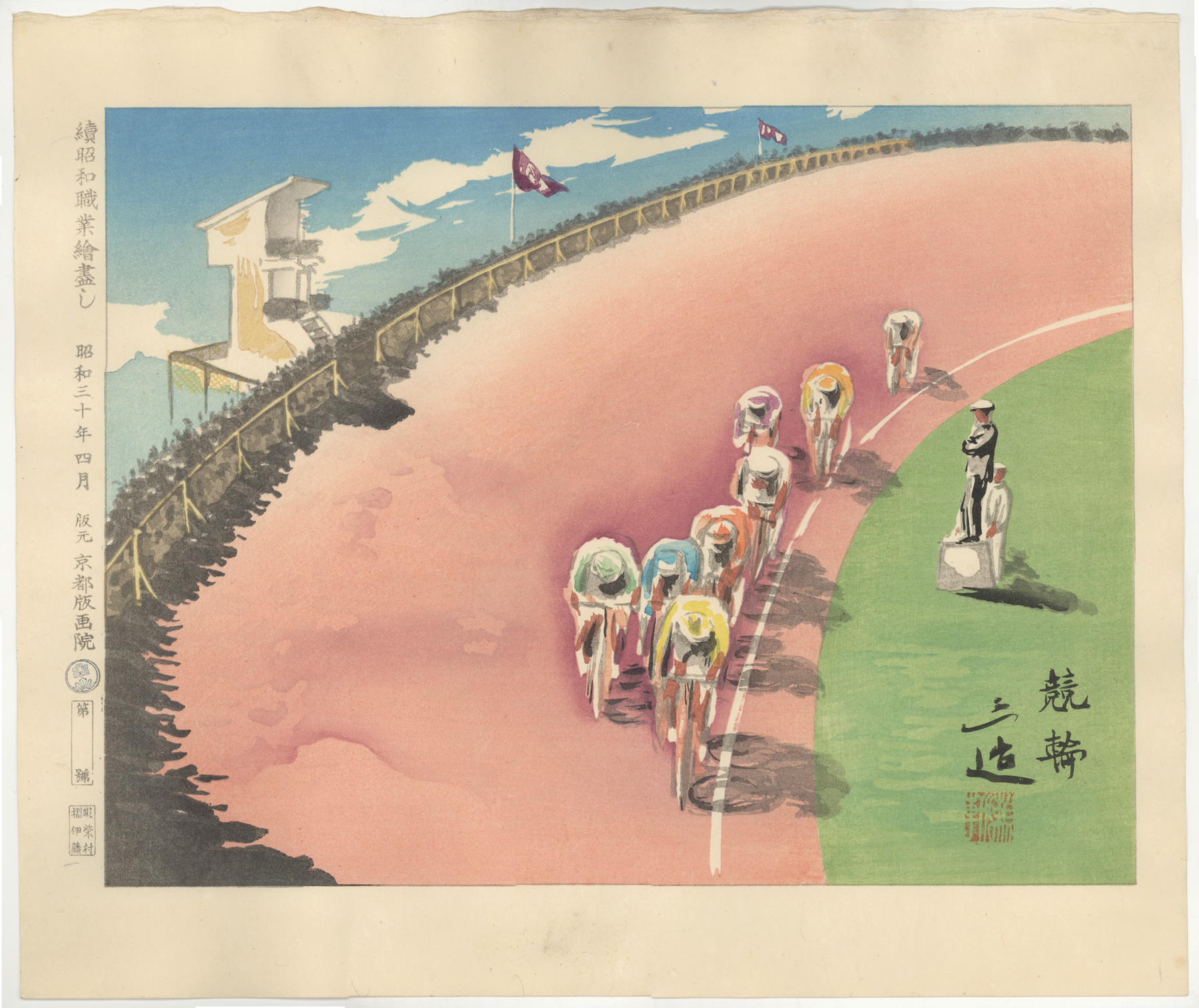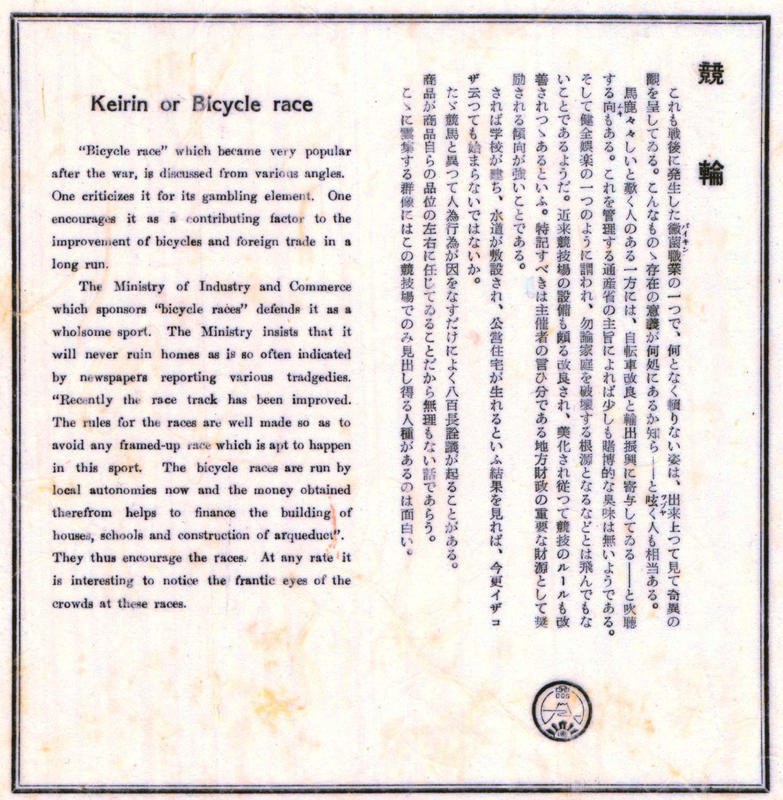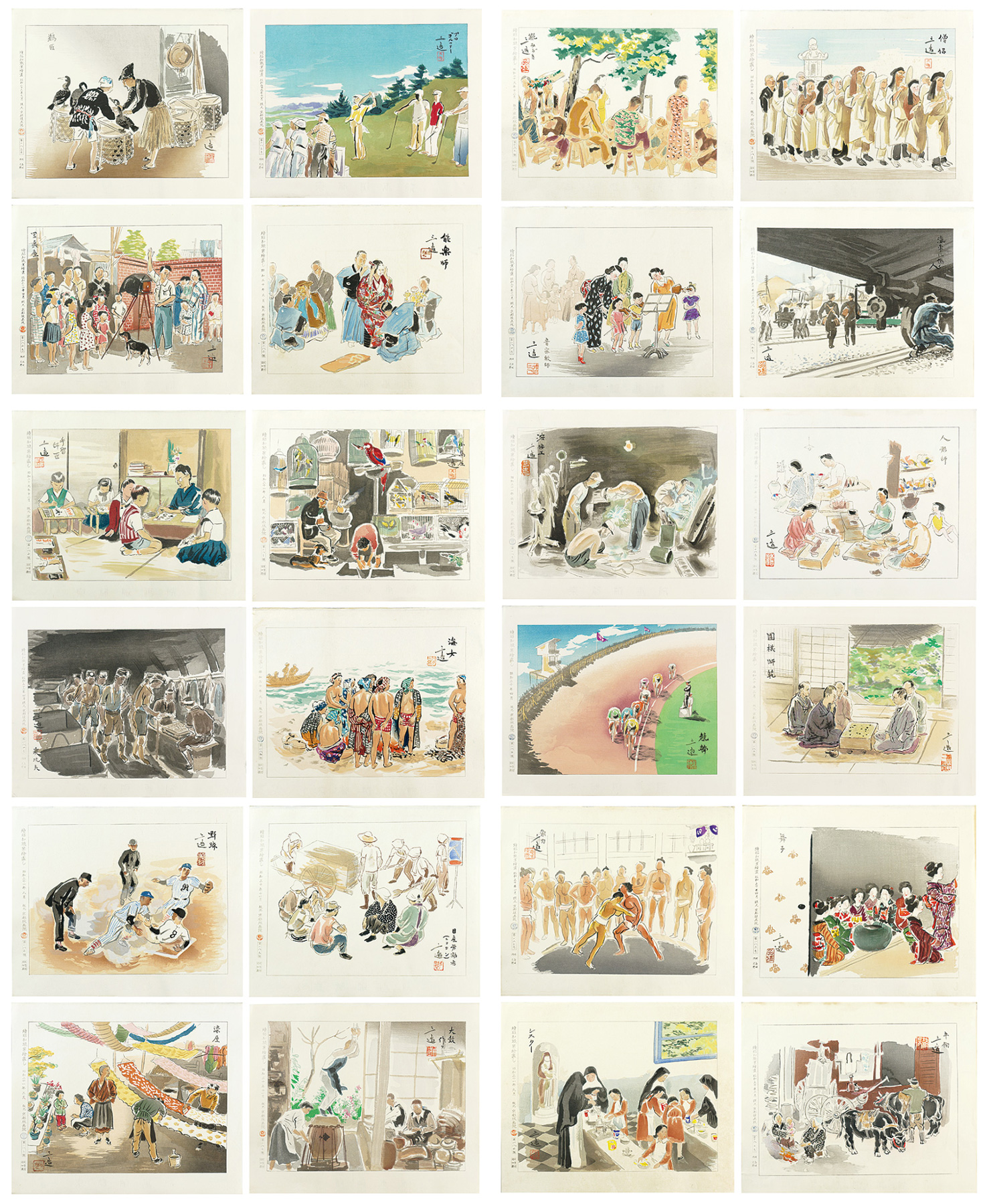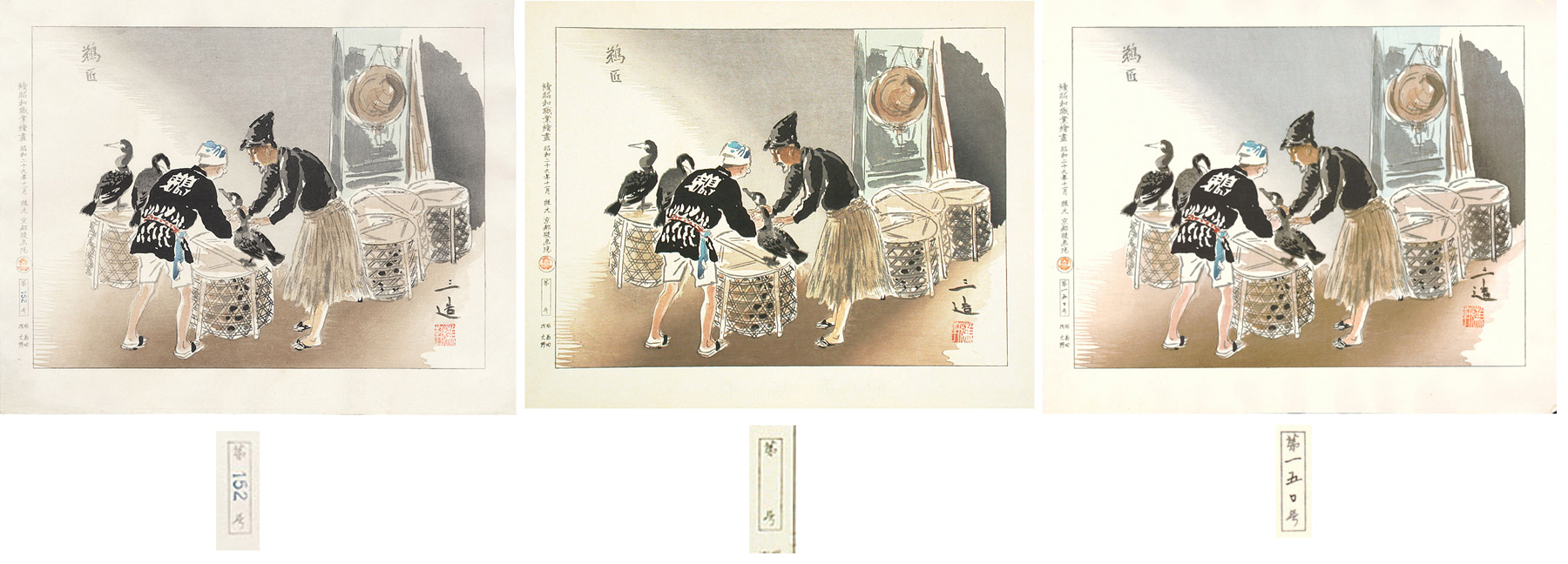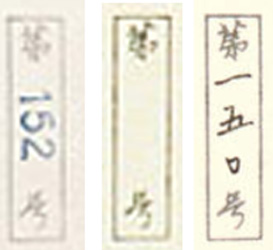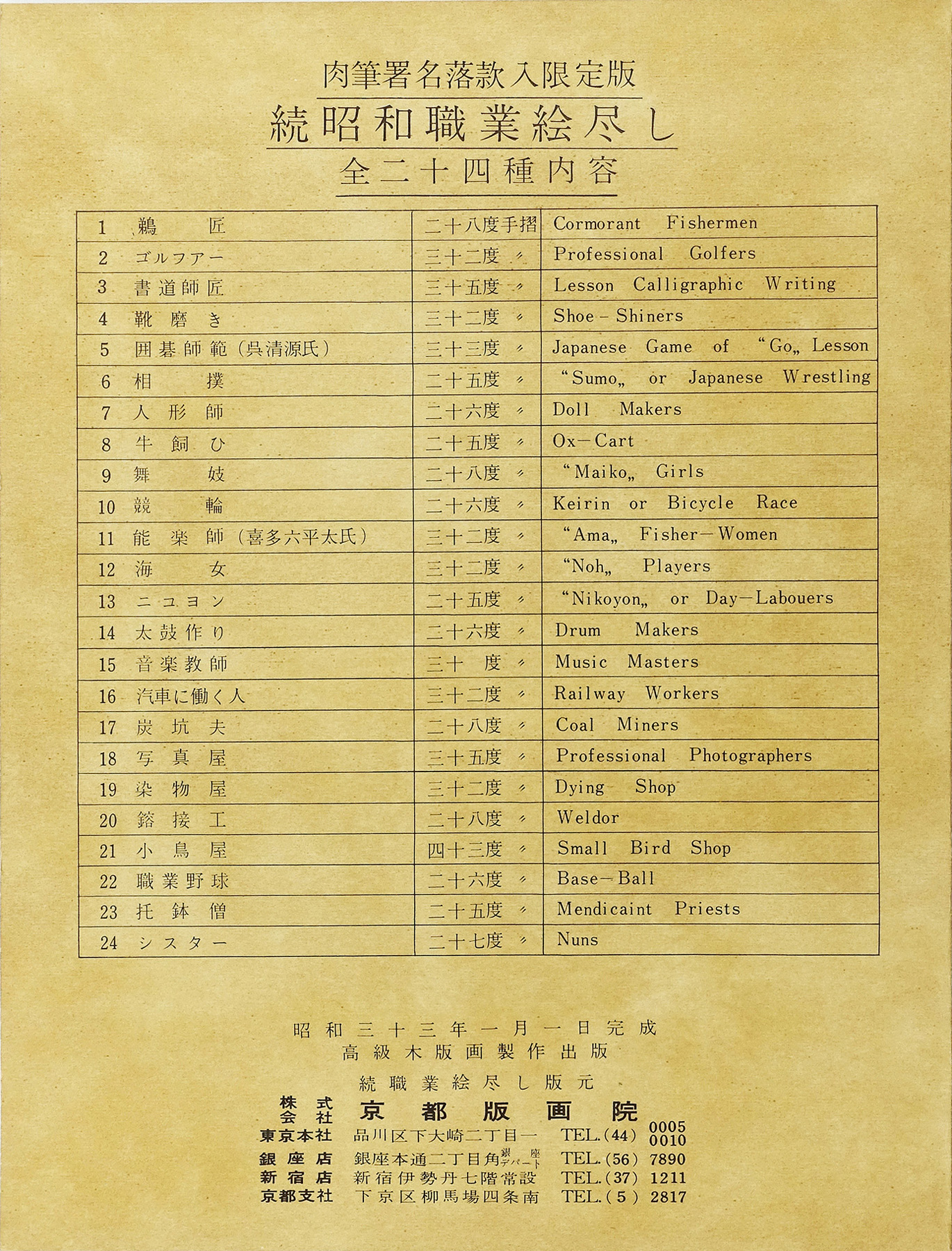About This PrintEight racers in colorful racing outfits enter the straightaway on a velodrome track in Japan. This print is one of twenty-four in the post-WWII print series Occupations of Shōwa Japan in Pictures, Continuing (3rd series), published from November 1954 through September 1956 by the publisher Shinagawa Kyoomi, owner of
Each print in this 3rd series came with an attached sheet (printed on a tissue-type paper) of commentary, written in both Japanese and English (translations by Shiraishi Fumio). In regards to the English translations provided, Memories of Shōwa: Impressions of Working Life by Wada Sanzō (p. 65) notes, "A different translator [from the pre-war series] worked on these descriptions, and some content was specifically edited for the English versions." The authors provide translations, shown in brackets below, of any significant lapses in translation that appear in the English translations on the commentary sheet.
Commentary sheet click on image to enlarge
Keirin or Bicycle Race
“Bicycle race” which became very popular after the war, isdiscussed from various angles. [Its somewhat vague appearance presents a strange spectacle. And this finds its expression in people grumbling that they do not know what the significance of its existence is.] Onecriticizes it for its gambling element. One encourages it as a contributing factor to the improvement of bicyclesand foreign trade in a long run. The Ministry of Industry and Commerce which sponsors “bicycleraces” defends it as a wholesome sport. The Ministry insists that it will never ruin homes as is so oftenindicated by newspapers reporting various tragedies. “Recently the race track has beenimproved. The rules for the races arewell made so as to avoid any framed-up race which is apt to happen in thissport. The bicycle races are run bylocal autonomies [sic] now and the money obtained therefrom helps to finance thebuilding of houses, schools and construction of arqueduct [sic]”. They thus encourage the races. At any rate it is interesting to notice thefrantic eyes of the crowds at these races. [And looking at the schools that are being built, waterways that are being constructed, and public housing that is being created as a result, it is really no use to say it is troublesome after all this time. However, contrary to horse-racing, match fixing caused by deliberate human action occurs often. Because the participant is entrusted to control his own ranking, I suppose that is to be expected.] At any rate it is interesting to notice the frantic eyes of the crowds at these races. |
History of Keirin
"Keirin racing originated in Kokura City in November 1948. It has since become a Japanese social institution attended by around 57 million spectators every year. It is also Japan’s most popular sanctioned betting sport. Japanese Keirin fans place bets amounting to 1.15 trillion Yen annually. In regard to public perception, Keirin compares most closely with greyhound or horse racing in the West. Races are held nearly every weekend at 50 tracks throughout Japan."
Keirin racing is a "track cycling event in which 6 to 9 sprinters compete at one time in a race with a paced start. Riders draw numbers to determine their starting positions and the race begins as the motorized pacer approaches. The riders are required to remain behind the pacer, which starts at the deliberately slow speed of about 16 mph, gradually increases speed, and leaves the track approximately 600-700 meters before the end. With a speed of often more than 40 mph, the first racer over the line is the winner. Keirin races are only about 2 kilometers long, or about 1.25 miles."
About the Three Part Series "Occupations of Shōwa Japan in Pictures"
Sources: website of Ross Walker Ohmi Gallery http://www.ohmigallery.com/DB/Artists/Sales/Wada_Sanzo.asp and website of USC Pacific Asian Museum "Exhibition - The Occupations of Shōwa Japan in Pictures: The Woodblock Prints of Wada Sanzō"
Note:
My special thanks to Shinagawa Daiwa, the current owner of Kyoto Hangain, for providing the below information (in a series of emails in July 2014) about Nishinomiya Shoin and Kyoto Hangain, both businesses started by his father Shinagawa Kyoomi. Shinagawa's current website can be accessed at http://www.amy.hi-ho.ne.jp/kyotohangain/ Wada’s major contribution as a woodblock print artist came through his 72 print 3-part series Occupations of Shōwa Japan in Pictures (Shōwa shokugyō e-zukishi), also translated as Occupations of the Shōwa Era in Pictures and Japanese Vocations in Pictures. The three part series was started during the Pacific War (1937-1945) in September 1938, was then interrupted by war shortages in 1943, and was restarted again after the war in January 1954. This series was a labor of love for Wada and he brought together woodblock print printers and carvers in Nishimomiya near Kobe to work on this project.
The war era prints were published by Wada through an old books store, Nishinomiya shoin 西宮書院 run by Shinagawa Kyoomi planned a total of 100 designs, with two prints being issued each month. Wada's designs for the prints were rendered in watercolor and the finished prints beautifully captured the look-and-feel of those original watercolors. The series was an immediate hit, but was suspended after 48 prints (issued in two series) in 1943 due to war shortages. After the war, the series was continued by the same publisher, Shinagawa Kyoomi, who had opened a new business in Kyoto, which he named Kyoto Hangain 京都版画院. (Shingawa's business in Nishinomiya had burned down during WWII.) At first Kyoto Hangain published re-prints of the earlier prints, but they went on to publish a third series of 24 prints, working closely with Wada, titled Continuing Occupations of Shōwa Japan in Pictures between November 1954 and September 1956.1 The post-war prints were popular with the Occupation's "deep-pocketed" military and civilian personnel and the series was "featured in an article of the Tokyo edition of the United States military newspaper Stars and Stripes."2 Shinagawa also published a six print portfolio in the 1950s titled Japanese Life and Customs, consisting of six of the prints from the earlier two series in a reduced chuban size, which is also part of this collection. Occupations of Shōwa Japan in Pictures has been praised for showing “the complexity of Shōwa society…. capture[ing] the pulse of Japanese life during the tumultuous decades of the 1930s, 1940s and 1950s”3 and condemned as providing a “visual message of subtle or blatant propaganda in support of government-sponsored ideas.”4 It is interesting to see how the commentary, written by the artist, that accompanied each print in the pre-war releases was softened for the post-war re-issues by Kyoto Hangain. All references to soldiers being away from home (as Japanese armies were marching through Asia when the series was originally released) or references to Imperial Japan have been stripped away and the commentary becomes innocent, folk-like and appealing to the post-war occupying forces. (For example, see the prints Women Weavers and Picture Card Show which provide the artist's original commentary and a full transcript of the English text attached to the folders of the post-war re-issued prints.)
1 Keizaburo Yamaguchi gives the publication dates of the post-War series as January 1954 through autumn 1958. (Ukiyo-e Art 16, 1967): 39-42. 2 "Out of the Dark Valley: Japanese Woodblock Prints and War, 1937-1945," Kendall H. Brown,p. 82 appearing in Impressions, The Journal of the Ukiyo-e Society of America, Inc., Number 23, 2001.3 Pacific Asia Museum website http://www.pacificasiamuseum.org/_on_view/exhibitions/2004/occshowa.aspx 4 Light in Darkness: Women in Japanese Prints of Early Shōwa (1926-1945), Kendall H. Brown, et. al., Fisher Gallery, University of Southern California, 1996, p. 18.
More About Occupations of Shōwa Japan in Pictures, Continuing (series 3)
This 1954-1956 post-war series of 24 prints, a continuation of the first two series issued from 1939 to 1941, depicts both traditional and modern occupations.
The Twenty-Four Prints Comprising "Occupations of Shōwa Japan in Pictures, Continuing (series 3)" click on image to enlarge
While the prints in the series are often described as being issued in a "limited edition" of 170 prints, there were at least two other limited editions, each of 200 prints, one using cardinal numbers in the edition cartouche, and one using Japanese numbers in the edition cartouche, as shown below. In addition many, if not all, of the prints were issued without any number in the edition cartouche, as shown below, making it impossible to determine how many total prints were made by the publisher.1
Examples of the same print, Cormorant Fishermen, with different edition information
Dr. Ross Walker on his Ohmi Gallery website notes, "Besides the album sets, I think pairs of prints were also issued to subscription members, so I'm assuming that the edition sizes were 200 for subscription and 200 for the album sets (total of 400 strikes per scene). This would explain the appearance of duplicate edition numbers for the same scene, and the fact that some prints are printed on watermarked paper [reading "京都版画院" - Kyoto hangain, the publishing house], while others are printed on un-watermarked paper of slightly smaller dimensions."2
On January 1, 1959 the publisher released a portfolio consisting of all 24 prints, which included the below table of contents. The size of the edition is not stated on the table of contents, but I have seen a print from this release with an edition number of 一九〇 (190), so an edition size of 200 is a reasonable guess.
The center column on the table of contents indicates the number of superimposed printings (手摺) for each print with the range being from 22 to 43. These numbers reflect the complexity of faithfully reproducing Wada's preparatory watercolor sketches.
click on image to enlarge The prints in this portfolio were all stamped, using Japanese numbers, with the individual print number stamped in the edition cartouche. Total edition size for the portfolio have been given as 170 and 200, suggesting two limited edition complete portfolios were made.
Information appearing on the top of the Table of Contents sheet
肉筆署名落款入限定版 (hand-signed limited edition prints)
續昭和職業繪尽し (Occupations of Shōwa Japan in Pictures, Continuing)
全二十四種内容 (contents - 24 pieces, complete set) |
Information appearing on the bottom of the Table of Contents sheet
昭和三十三年一月一日完成 (completed on January 1 1958)* 高級木版画掣作出版 (high-class woodblock print publishing) 続職業絵尽し 版元 (Occupations in Pictures, Continuing - publisher ) 株式 会社 京都版画院 (Joint stock company - Kyoto hangain)
* the last print in the series is dated September 1956. This January 1, 1958 may refer to a re-printing of the entire series or the release date of this portfolio. |
1 The absence of a stamped edition number on many prints likely indicates that an unspecified number of prints in addition to the numbered editions were issued. A less likely explanation for the lack of edition number on certain prints is that it was inadvertently left off.
Print Details | IHL Catalog | #1320 | | Title/Description | Keirin or Bicycle Race (Keirin 競輪) | | Series | Occupations of Shōwa Japan in Pictures, Continuing (series 3)
[sometimes translated as Vocations (or Occupations) of Shōwa Japan in Pictures, Continuing; Continuing Sketches of Occupations in Shōwa Era; Continuing Illustrations of Showa Era Occupations]
Shoku Shōwa shokugyō e-zukushi 續昭和職業繪盡し
Zoku Shōwa shokugyō e-zukushi 続昭和職業絵尽し | Artist
| Wada Sanzō (1883-1967)
| Signature
| 三造 Sanzō | | Seal | unread | | Publication Date | April 1955
Shōwa 30, 4th month | | Publisher | Kyoto Hangain
hanmoto Kyoto Hangain 版元 京都版画院 with Shinagawa seal | | Edition | 苐 號
note: the number of the print in the edition is left blank on this print. | | Carver | 彫 柴村 carver Shibamura [Shibamura Shinnosuke] | | Printer | (see image above) 摺 伊藤 printer Itō [Itō Toraji] | | Impression | excellent | | Colors | excellent | | Condition | excellent- minor soiling bottom margin; mounting remnants top margin verso
| | Genre | shin hanga
| | Miscellaneous | 26 superimposed printings; not printed on watermarked paper | | Format | dai-oban
| | H x W Paper | 13 3/4 x 16 5/16 in. (34.9 x 41.4 cm)
| | H x W Image | 10 13/16 x 14 7/16 in. (27.4 x 36.7 cm) | | Collections This Print | | | Reference Literature | Memories of Shōwa: Impressions of Working Life by Wada Sanzō, Maureen de Vries and Daphne van der Molen, Nihon no hanga, 2021 |
last revision:8/10/2021 3/17/2020 12/5/2018 |





